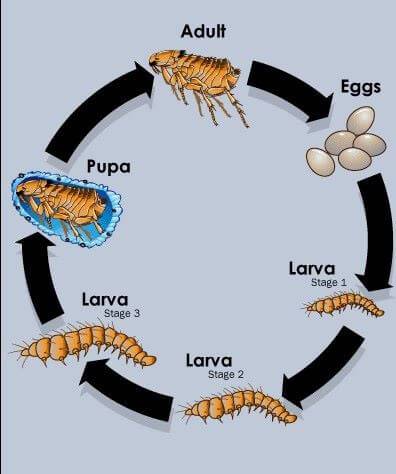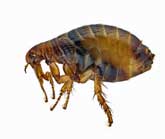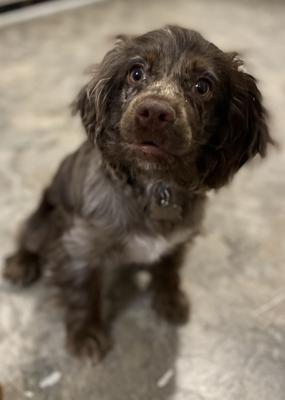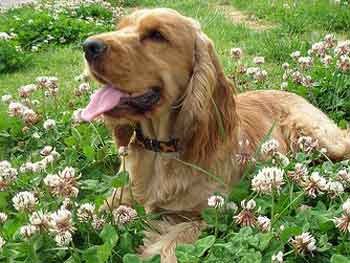- Home
- Dog Fleas and Ticks
- Dog flea life cycle
Breaking The Dog Flea Life Cycle
It's essential to understand the flea life cycle because simply killing the fleas on your dog isn't enough; the fleas will just keep coming!
Learn everything you need to know to break the life cycle of fleas and banish those bloodsucking parasites for good by staying one jump ahead!
How To Get Rid of Fleas!
Getting rid of fleas on your dog isn't just about killing off adult fleas.
You also have to stop the development of existing eggs, larvae and pupae; otherwise, they'll continue to develop into adult fleas and begin the cycle again!
By understanding the flea life cycle and its habitat, you'll take the first step to getting rid of your dog's fleas for good!
The Life Cycle Of Fleas
The flea life cycle consists of four stages: adult, egg, larva, and pupa.
 Dog flea life cycle
Dog flea life cycleStage 1: Flea Life Cycle - Adult Fleas
Adult dog fleas feed on blood from your pet. They're really not fussy whose blood they drink; fleas will also feed on you if they get the opportunity.
Once fleas settle on a host, they feed, mate, and lay eggs in that order.
The adult female flea can lay between 30 and 50 eggs a day and up to 200 in her lifetime (and that's just one flea!). Doesn't bear thinking about, does it?
Adults account for only 5% of the flea population. This means the other 95% are somewhere in the flea life cycle; on their way to becoming fully grown fleas, ready to begin mating again!
Adult fleas can live up to 100 days; however, they don't usually live for much longer than 10 days on your dog. This is because many will die and drop off your pet after the dog has been treated for fleas, or he'll remove them as they bite him (that's what he's doing when he's nipping, nibbling and scratching at his fur).
New adults (those that haven't yet fed on blood) feed on flea droppings, dead skin and fungus, and they can live up to two years without feeding on blood.
The good news is that they cannot produce eggs until after their first blood meal. However, after their first taste of blood, they must feed every few hours.
Gory, isn't it?
So, adult fleas are more likely to be found on your dog (it's their feeding ground!). In contrast, immature fleas are more likely to be found in your Cocker Spaniel's bedding, around the home, and in your carpets.
Stage 2: Flea Life Cycle - Eggs
Flea eggs are oval, slightly opalescent and about the size of a grain of sand, and they don't need to live on your dog to survive. Think about that for a minute!
The adult flea may lay her eggs in your Cocker's coat, but because flea eggs are dry and loose, they can (and often do) fall very easily onto carpets, bedding, furniture, and grass; in fact, your dog can lead a trail of flea eggs wherever he goes!
The eggs can survive most conditions and endure severe temperature changes, even to the point of drying out; however, they usually hatch between two days and two weeks, depending on the temperature and humidity.
In some cases, the eggs may lie dormant for up to two years, and as soon as conditions are just right, they will begin to develop.
And, just when you think you've won the war against fleas, back, they come!
Stage 3: Fleas Life Cycle - Larvae
The larva breaks through the soft egg 'shell' using a hard spike on the top of its head, known as a chitin tooth. As it matures, the flea will lose this cutting tooth during the moulting process.
Flea larvae are around 2-3 mm long and look similar to maggots. They are blind and don't like the light.
Larvae prefer humid conditions, which is why they're more likely to be found in dark, sheltered places such as cracks, crevices, under furniture or among your dog's bedding.
They feed on dried blood from the droppings of adult fleas, hair, dead skin, and other organic matter found deep in the pile of your carpets or in your dog's bed.
Larvae moult through three stages, or instars, lasting from 5 days to several months depending upon conditions and grow bigger between each moulting stage.
They spin a silken cocoon when the third and final stage is complete. Pet hair, carpet fibres, dust, etc., stick to this silken covering and form a protective camouflage.
When conditions are just right, they pupate.
Stage 4: Flea Life Cycle - Pupae
The pupa is the final stage, where the larval form changes to an adult flea inside the cocoon.
Although the pupal stage lasts between a week and ten days, the flea may remain in the cocoon, protected against the elements and predators, just waiting for the right conditions before emerging.
Such conditions would be warmth, humidity, vibration, or carbon dioxide - signs that a food source and accommodation, i.e. animals or humans, are nearby.
And so the process begins again; the fleas find a suitable host, the fleas feed, mate, and the female lays her eggs.
Flea Life Cycle: The Movie!
You've read the book, now watch the movie!
For those that prefer visuals, I thought I would add this short video showing the life cycle of dog fleas. I hope you enjoy watching it.
Life Cycle of Fleas: Summary
Now that you understand more about the dog flea's life cycle, it's easy to see that killing the adult fleas alone won't necessarily eliminate an infestation. It's a good start, but you've also got to get rid of the eggs, larvae and pupae; otherwise, the fleas will return.
Temperature and humidity significantly impact how long the eggs take to progress to adult fleas. This means that the flea life cycle can come full circle in summer within a couple of weeks.
However, when the weather is cooler, it can take up to 2 years for the fleas to progress from eggs to adults.
This is why it's essential to be on the lookout for evidence of dog fleas (for example, eggs or dried blood) to begin treating your Cocker Spaniel immediately.
If you think your Cocker has fleas, click on the photo below to learn how to eliminate them here.
Getting Rid of Dog Fleas
|
Getting rid of a flea infestation on your dog and in your home can take a long time, especially if you didn't notice early enough that your dog had fleas! If you'd like to learn how to get rid of fleas on your dog (and in your home) click on this little bloodsucker to your right. |
Photo Credits for Flea Cycle on Dogs:
1. Unknown



